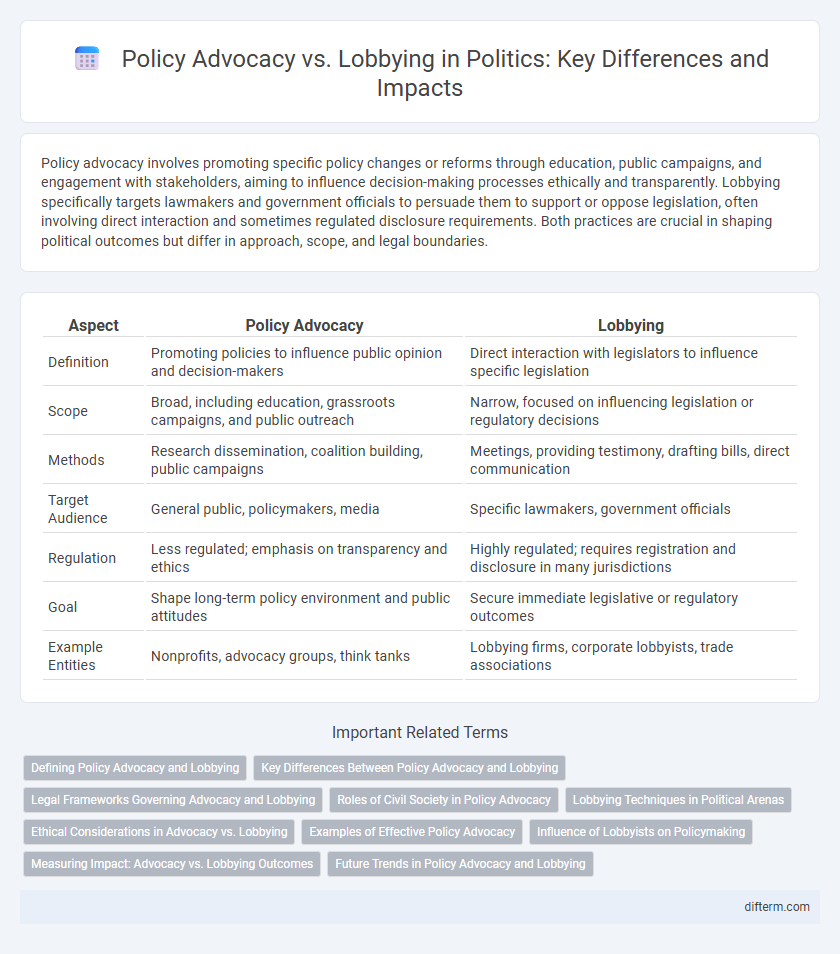Policy advocacy involves promoting specific policy changes or reforms through education, public campaigns, and engagement with stakeholders, aiming to influence decision-making processes ethically and transparently. Lobbying specifically targets lawmakers and government officials to persuade them to support or oppose legislation, often involving direct interaction and sometimes regulated disclosure requirements. Both practices are crucial in shaping political outcomes but differ in approach, scope, and legal boundaries.
Table of Comparison
| Aspect | Policy Advocacy | Lobbying |
|---|---|---|
| Definition | Promoting policies to influence public opinion and decision-makers | Direct interaction with legislators to influence specific legislation |
| Scope | Broad, including education, grassroots campaigns, and public outreach | Narrow, focused on influencing legislation or regulatory decisions |
| Methods | Research dissemination, coalition building, public campaigns | Meetings, providing testimony, drafting bills, direct communication |
| Target Audience | General public, policymakers, media | Specific lawmakers, government officials |
| Regulation | Less regulated; emphasis on transparency and ethics | Highly regulated; requires registration and disclosure in many jurisdictions |
| Goal | Shape long-term policy environment and public attitudes | Secure immediate legislative or regulatory outcomes |
| Example Entities | Nonprofits, advocacy groups, think tanks | Lobbying firms, corporate lobbyists, trade associations |
Defining Policy Advocacy and Lobbying
Policy advocacy involves promoting specific public policies or social causes by informing and influencing policymakers and the public through research, education, and grassroots mobilization. Lobbying is a targeted activity where individuals or groups directly communicate with legislators or government officials to persuade them to enact, amend, or reject legislation, often involving formal registration and reporting requirements. While both aim to shape public policy, lobbying is more narrowly defined by legal frameworks regulating direct interaction with policymakers, whereas policy advocacy encompasses broader strategies to impact policy decisions.
Key Differences Between Policy Advocacy and Lobbying
Policy advocacy aims to influence public opinion and government decisions through education, campaigns, and community engagement, targeting broad societal change. Lobbying specifically involves direct interaction with legislators or government officials to persuade them to enact, modify, or reject legislation. While advocacy focuses on long-term systemic impact, lobbying seeks immediate legislative outcomes and often requires registration and disclosure under legal frameworks.
Legal Frameworks Governing Advocacy and Lobbying
Legal frameworks distinguish policy advocacy from lobbying by defining the scope of permissible activities and disclosure requirements. Advocacy typically involves public education and mobilizing citizen support without direct influence on specific legislation, whereas lobbying requires registration and detailed reporting to regulatory authorities when attempting to influence lawmakers. Compliance with laws such as the Lobbying Disclosure Act in the United States or the Transparency of Lobbying, Non-party Campaigning and Trade Union Administration Act in the UK ensures accountability and transparency in interactions between interest groups and government officials.
Roles of Civil Society in Policy Advocacy
Civil society plays a crucial role in policy advocacy by representing diverse citizen interests, raising public awareness, and influencing decision-makers to adopt equitable policies. Unlike lobbying, which often involves direct interaction with legislators to influence specific legislation, civil society engages in grassroots mobilization, research dissemination, and dialogue facilitation. These roles strengthen democratic participation and ensure policies reflect the needs and rights of marginalized communities.
Lobbying Techniques in Political Arenas
Lobbying techniques in political arenas involve direct engagement with policymakers through formal meetings, testimony during legislative sessions, and the submission of detailed policy briefs. Effective lobbyists deploy grassroots campaigns, leveraging public opinion to influence legislative agendas and mobilize community support. Utilizing digital platforms and data analytics enhances targeting precision, ensuring tailored messaging reaches key decision-makers efficiently.
Ethical Considerations in Advocacy vs. Lobbying
Ethical considerations in policy advocacy emphasize transparency, truthfulness, and the promotion of public interest without undue influence, whereas lobbying often raises concerns about conflicts of interest and disproportionate access to power. Advocates are held to strict standards of honesty and accountability, ensuring their efforts support democratic processes and equitable policy outcomes. Lobbying practices require vigilant regulation to prevent corruption and maintain trust in political decision-making.
Examples of Effective Policy Advocacy
Effective policy advocacy often involves grassroots campaigns that mobilize public support, such as the environmental movement's push for renewable energy legislation. Nonprofits like the American Civil Liberties Union utilize strategic research and public education to influence lawmakers on civil rights issues. These efforts contrast with lobbying, where direct interaction with legislators, exemplified by pharmaceutical companies advocating for drug pricing regulations, plays a central role.
Influence of Lobbyists on Policymaking
Lobbyists play a critical role in shaping public policy by providing lawmakers with detailed expertise, data, and constituent perspectives that inform decision-making. Their influence often stems from strategic relationships and sustained communication with policymakers, enabling them to advocate effectively for specific interests or regulations. Unlike broader policy advocacy, lobbying targets legislation and regulatory frameworks directly, using tailored arguments and resources to sway votes and policy outcomes.
Measuring Impact: Advocacy vs. Lobbying Outcomes
Measuring the impact of policy advocacy versus lobbying involves distinct metrics due to their different approaches; advocacy outcomes often reflect changes in public awareness, grassroots mobilization, and long-term legislative shifts, while lobbying results are typically quantified through direct legislative or regulatory changes. Advocacy success can be evaluated by tracking shifts in public opinion, media coverage, and coalition growth, whereas lobbying effectiveness is assessed by the number of policy proposals influenced or the passage of desired laws. Data-driven analysis combining qualitative feedback and quantitative indicators provides a comprehensive view of how each strategy advances policy goals.
Future Trends in Policy Advocacy and Lobbying
Emerging technologies like artificial intelligence and data analytics are transforming future trends in policy advocacy and lobbying by enabling targeted messaging and real-time influence measurement. Increasing regulatory scrutiny is pushing lobbyists towards greater transparency and ethical standards, reshaping strategies around compliance and stakeholder engagement. Collaborative platforms and grassroots mobilization are expected to grow, amplifying direct citizen involvement in shaping legislative outcomes.
policy advocacy vs lobbying Infographic

 difterm.com
difterm.com